BUSN20016: Women Economic Empowerment Mobilization in Australia
VerifiedAdded on 2023/06/03
|15
|4376
|301
Project
AI Summary
This research project investigates the mobilization of women's economic empowerment in Australia, focusing on the roles of various institutions and stakeholders. It aims to identify the methods used by these entities to empower women and the benefits achieved. The study addresses gaps in existing literature by exploring the strategies employed by institutions, examining changes in women's status over the past decade, evaluating Australia's efforts towards women's economic empowerment, and identifying potential challenges. The research employs secondary data analysis to answer key questions about institutional involvement, progress in women's status, and obstacles to further empowerment. It highlights the contributions of organizations like the UN, UNESCO, and the Australian Department of Foreign Affairs, as well as stakeholders such as political parties, civil societies, NGOs, and academic institutions. The project aims to inform policymakers, economists, and other experts on effective approaches to promoting gender equality and improving women's conditions in Australia.
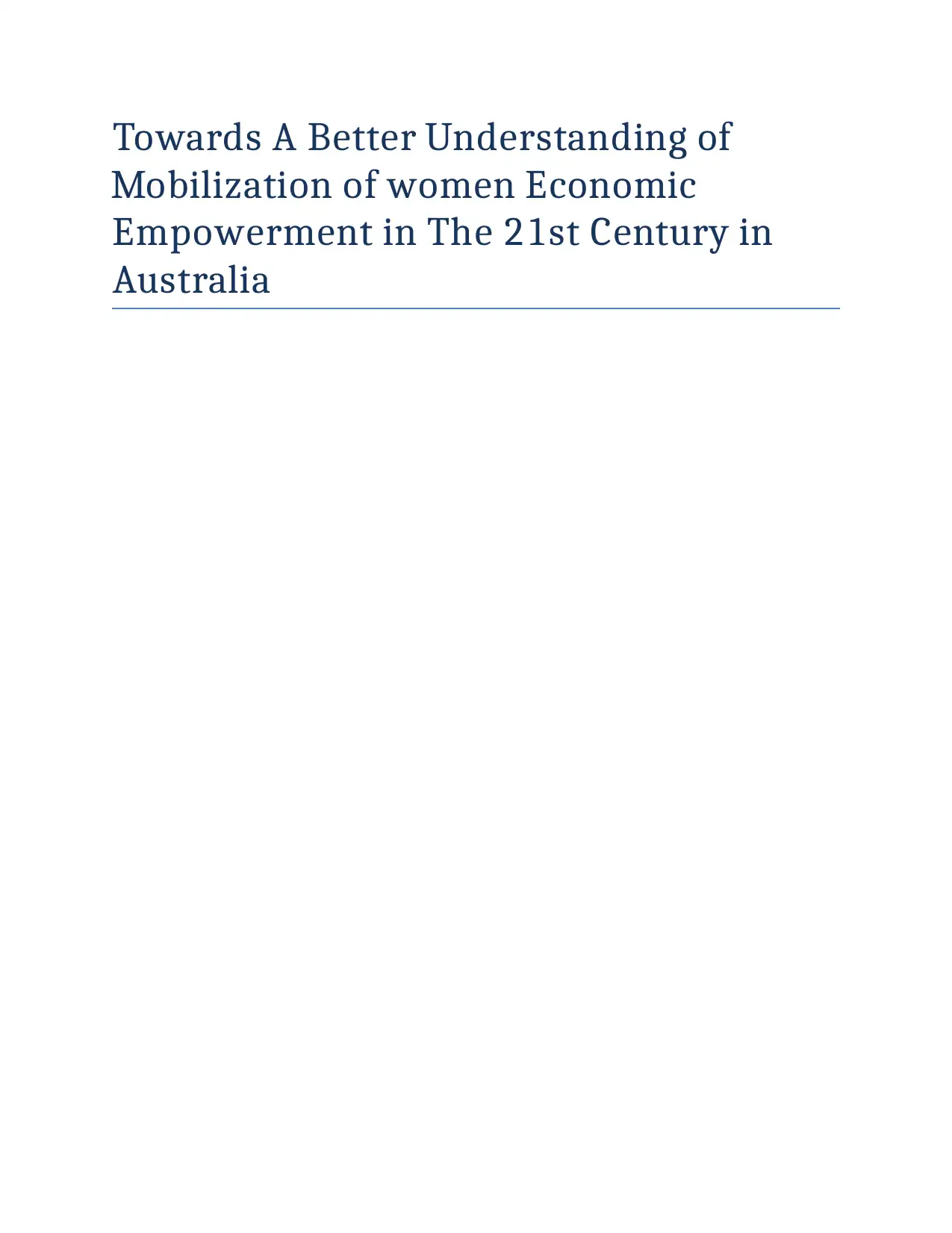
Towards A Better Understanding of
Mobilization of women Economic
Empowerment in The 21st Century in
Australia
Mobilization of women Economic
Empowerment in The 21st Century in
Australia
Paraphrase This Document
Need a fresh take? Get an instant paraphrase of this document with our AI Paraphraser
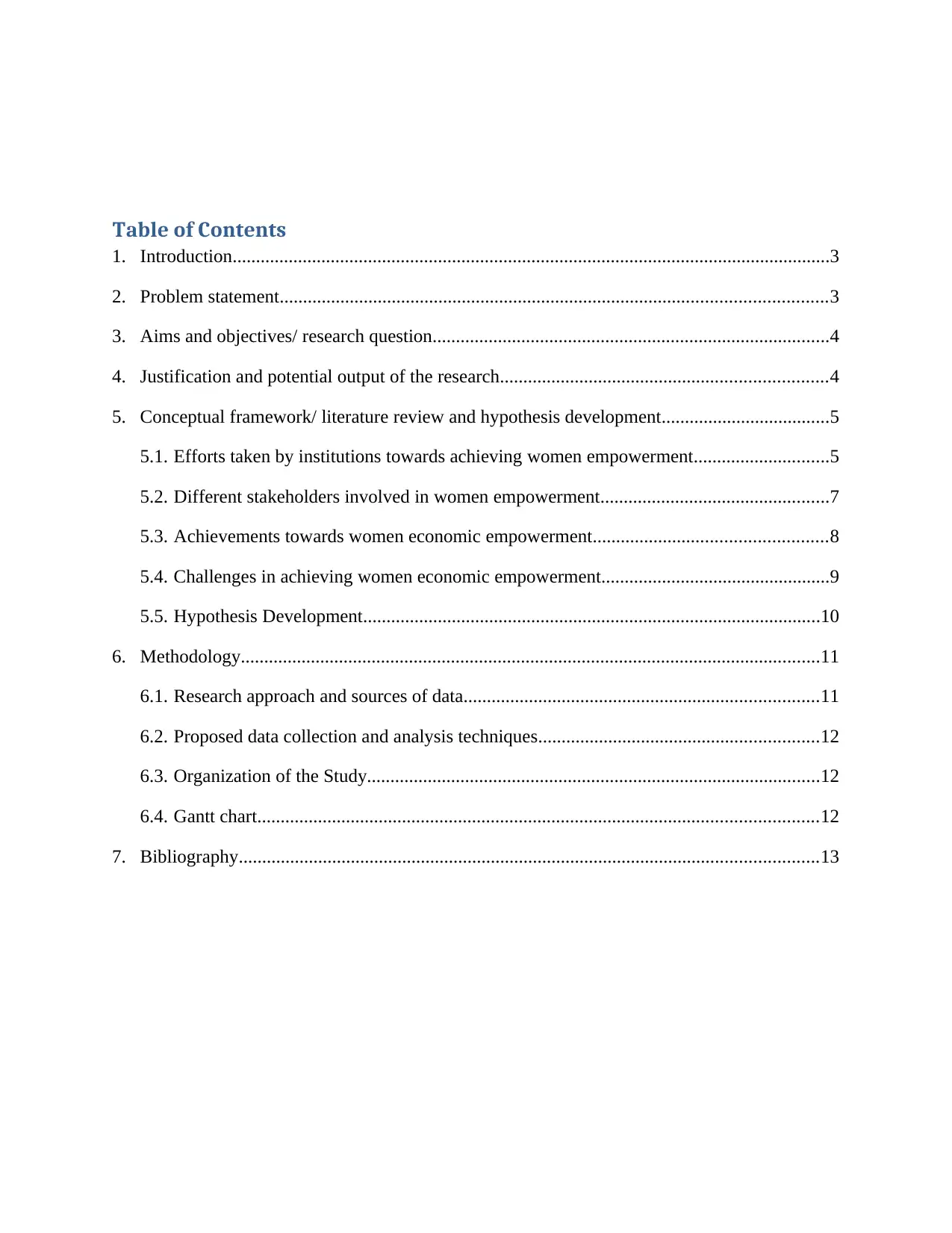
Table of Contents
1. Introduction................................................................................................................................3
2. Problem statement.....................................................................................................................3
3. Aims and objectives/ research question.....................................................................................4
4. Justification and potential output of the research......................................................................4
5. Conceptual framework/ literature review and hypothesis development....................................5
5.1. Efforts taken by institutions towards achieving women empowerment.............................5
5.2. Different stakeholders involved in women empowerment.................................................7
5.3. Achievements towards women economic empowerment..................................................8
5.4. Challenges in achieving women economic empowerment.................................................9
5.5. Hypothesis Development..................................................................................................10
6. Methodology............................................................................................................................11
6.1. Research approach and sources of data............................................................................11
6.2. Proposed data collection and analysis techniques............................................................12
6.3. Organization of the Study.................................................................................................12
6.4. Gantt chart........................................................................................................................12
7. Bibliography............................................................................................................................13
1. Introduction................................................................................................................................3
2. Problem statement.....................................................................................................................3
3. Aims and objectives/ research question.....................................................................................4
4. Justification and potential output of the research......................................................................4
5. Conceptual framework/ literature review and hypothesis development....................................5
5.1. Efforts taken by institutions towards achieving women empowerment.............................5
5.2. Different stakeholders involved in women empowerment.................................................7
5.3. Achievements towards women economic empowerment..................................................8
5.4. Challenges in achieving women economic empowerment.................................................9
5.5. Hypothesis Development..................................................................................................10
6. Methodology............................................................................................................................11
6.1. Research approach and sources of data............................................................................11
6.2. Proposed data collection and analysis techniques............................................................12
6.3. Organization of the Study.................................................................................................12
6.4. Gantt chart........................................................................................................................12
7. Bibliography............................................................................................................................13
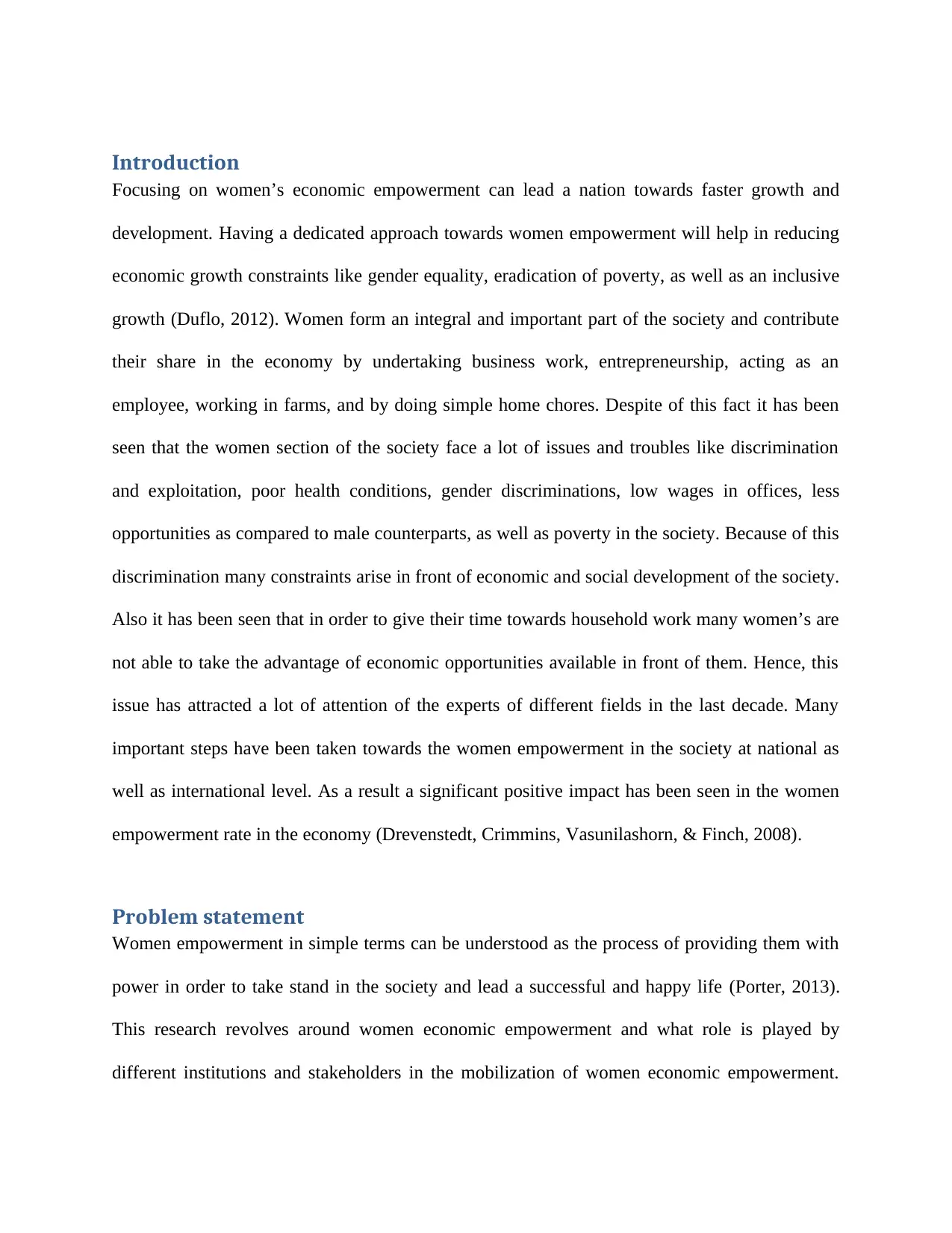
Introduction
Focusing on women’s economic empowerment can lead a nation towards faster growth and
development. Having a dedicated approach towards women empowerment will help in reducing
economic growth constraints like gender equality, eradication of poverty, as well as an inclusive
growth (Duflo, 2012). Women form an integral and important part of the society and contribute
their share in the economy by undertaking business work, entrepreneurship, acting as an
employee, working in farms, and by doing simple home chores. Despite of this fact it has been
seen that the women section of the society face a lot of issues and troubles like discrimination
and exploitation, poor health conditions, gender discriminations, low wages in offices, less
opportunities as compared to male counterparts, as well as poverty in the society. Because of this
discrimination many constraints arise in front of economic and social development of the society.
Also it has been seen that in order to give their time towards household work many women’s are
not able to take the advantage of economic opportunities available in front of them. Hence, this
issue has attracted a lot of attention of the experts of different fields in the last decade. Many
important steps have been taken towards the women empowerment in the society at national as
well as international level. As a result a significant positive impact has been seen in the women
empowerment rate in the economy (Drevenstedt, Crimmins, Vasunilashorn, & Finch, 2008).
Problem statement
Women empowerment in simple terms can be understood as the process of providing them with
power in order to take stand in the society and lead a successful and happy life (Porter, 2013).
This research revolves around women economic empowerment and what role is played by
different institutions and stakeholders in the mobilization of women economic empowerment.
Focusing on women’s economic empowerment can lead a nation towards faster growth and
development. Having a dedicated approach towards women empowerment will help in reducing
economic growth constraints like gender equality, eradication of poverty, as well as an inclusive
growth (Duflo, 2012). Women form an integral and important part of the society and contribute
their share in the economy by undertaking business work, entrepreneurship, acting as an
employee, working in farms, and by doing simple home chores. Despite of this fact it has been
seen that the women section of the society face a lot of issues and troubles like discrimination
and exploitation, poor health conditions, gender discriminations, low wages in offices, less
opportunities as compared to male counterparts, as well as poverty in the society. Because of this
discrimination many constraints arise in front of economic and social development of the society.
Also it has been seen that in order to give their time towards household work many women’s are
not able to take the advantage of economic opportunities available in front of them. Hence, this
issue has attracted a lot of attention of the experts of different fields in the last decade. Many
important steps have been taken towards the women empowerment in the society at national as
well as international level. As a result a significant positive impact has been seen in the women
empowerment rate in the economy (Drevenstedt, Crimmins, Vasunilashorn, & Finch, 2008).
Problem statement
Women empowerment in simple terms can be understood as the process of providing them with
power in order to take stand in the society and lead a successful and happy life (Porter, 2013).
This research revolves around women economic empowerment and what role is played by
different institutions and stakeholders in the mobilization of women economic empowerment.
⊘ This is a preview!⊘
Do you want full access?
Subscribe today to unlock all pages.

Trusted by 1+ million students worldwide
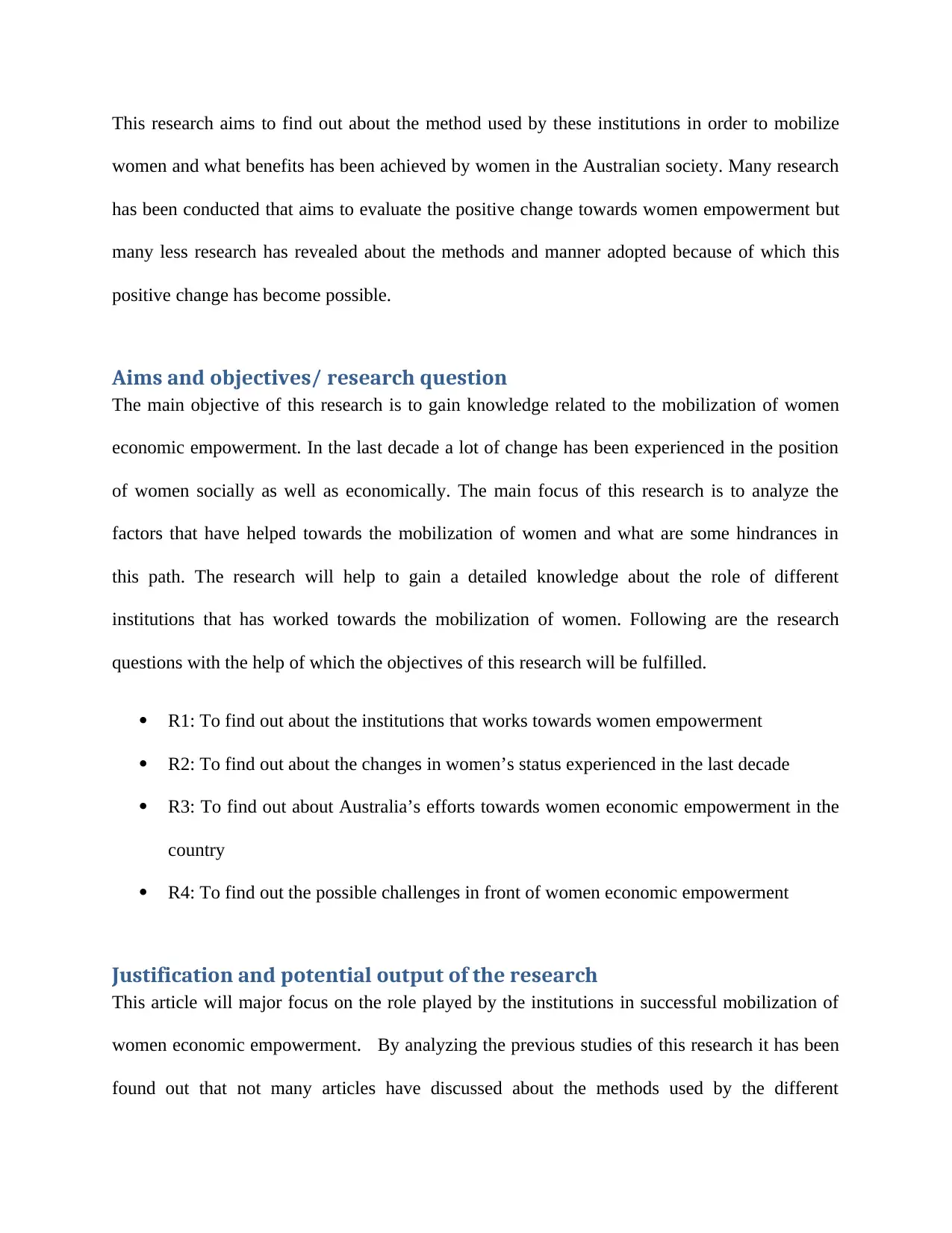
This research aims to find out about the method used by these institutions in order to mobilize
women and what benefits has been achieved by women in the Australian society. Many research
has been conducted that aims to evaluate the positive change towards women empowerment but
many less research has revealed about the methods and manner adopted because of which this
positive change has become possible.
Aims and objectives/ research question
The main objective of this research is to gain knowledge related to the mobilization of women
economic empowerment. In the last decade a lot of change has been experienced in the position
of women socially as well as economically. The main focus of this research is to analyze the
factors that have helped towards the mobilization of women and what are some hindrances in
this path. The research will help to gain a detailed knowledge about the role of different
institutions that has worked towards the mobilization of women. Following are the research
questions with the help of which the objectives of this research will be fulfilled.
R1: To find out about the institutions that works towards women empowerment
R2: To find out about the changes in women’s status experienced in the last decade
R3: To find out about Australia’s efforts towards women economic empowerment in the
country
R4: To find out the possible challenges in front of women economic empowerment
Justification and potential output of the research
This article will major focus on the role played by the institutions in successful mobilization of
women economic empowerment. By analyzing the previous studies of this research it has been
found out that not many articles have discussed about the methods used by the different
women and what benefits has been achieved by women in the Australian society. Many research
has been conducted that aims to evaluate the positive change towards women empowerment but
many less research has revealed about the methods and manner adopted because of which this
positive change has become possible.
Aims and objectives/ research question
The main objective of this research is to gain knowledge related to the mobilization of women
economic empowerment. In the last decade a lot of change has been experienced in the position
of women socially as well as economically. The main focus of this research is to analyze the
factors that have helped towards the mobilization of women and what are some hindrances in
this path. The research will help to gain a detailed knowledge about the role of different
institutions that has worked towards the mobilization of women. Following are the research
questions with the help of which the objectives of this research will be fulfilled.
R1: To find out about the institutions that works towards women empowerment
R2: To find out about the changes in women’s status experienced in the last decade
R3: To find out about Australia’s efforts towards women economic empowerment in the
country
R4: To find out the possible challenges in front of women economic empowerment
Justification and potential output of the research
This article will major focus on the role played by the institutions in successful mobilization of
women economic empowerment. By analyzing the previous studies of this research it has been
found out that not many articles have discussed about the methods used by the different
Paraphrase This Document
Need a fresh take? Get an instant paraphrase of this document with our AI Paraphraser
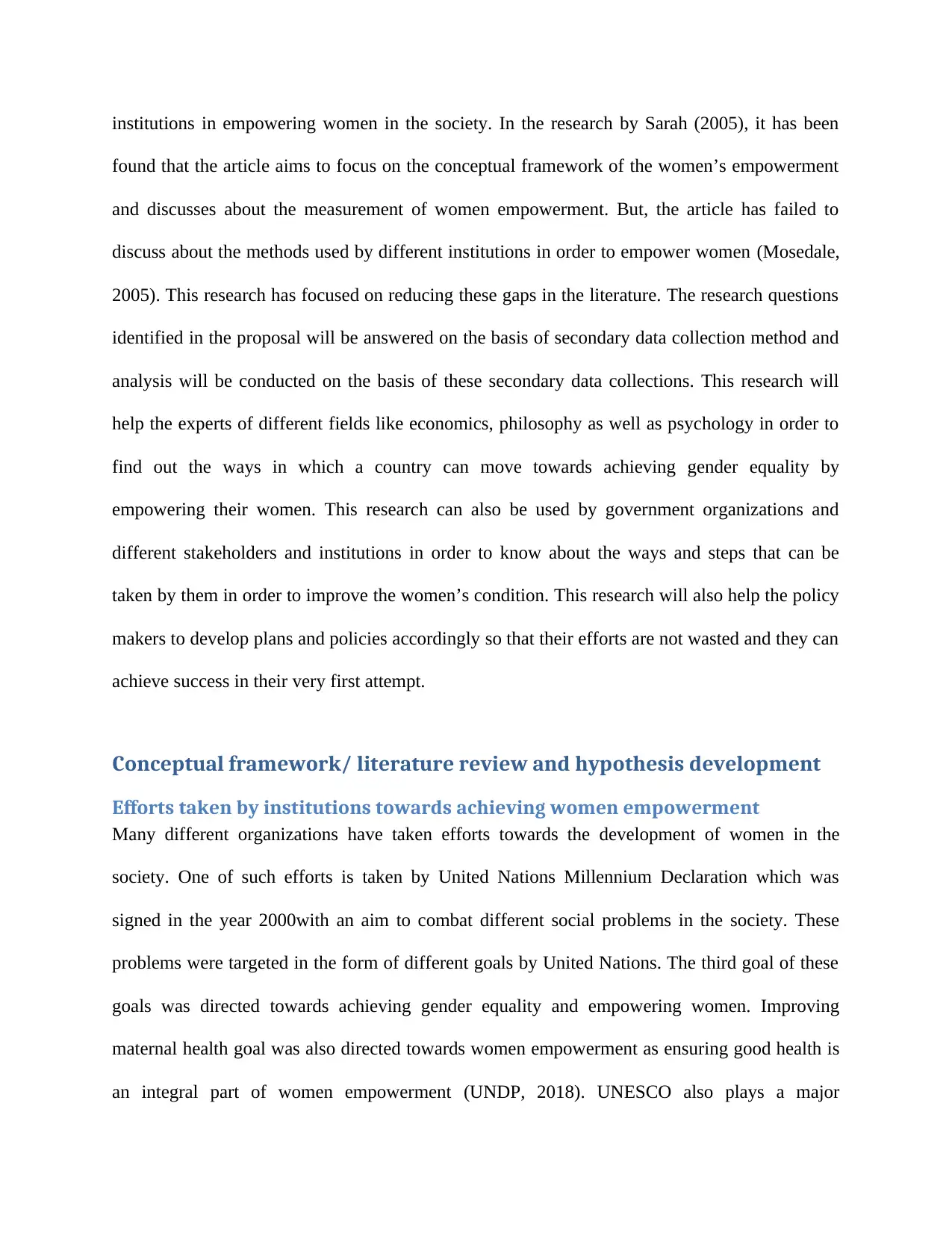
institutions in empowering women in the society. In the research by Sarah (2005), it has been
found that the article aims to focus on the conceptual framework of the women’s empowerment
and discusses about the measurement of women empowerment. But, the article has failed to
discuss about the methods used by different institutions in order to empower women (Mosedale,
2005). This research has focused on reducing these gaps in the literature. The research questions
identified in the proposal will be answered on the basis of secondary data collection method and
analysis will be conducted on the basis of these secondary data collections. This research will
help the experts of different fields like economics, philosophy as well as psychology in order to
find out the ways in which a country can move towards achieving gender equality by
empowering their women. This research can also be used by government organizations and
different stakeholders and institutions in order to know about the ways and steps that can be
taken by them in order to improve the women’s condition. This research will also help the policy
makers to develop plans and policies accordingly so that their efforts are not wasted and they can
achieve success in their very first attempt.
Conceptual framework/ literature review and hypothesis development
Efforts taken by institutions towards achieving women empowerment
Many different organizations have taken efforts towards the development of women in the
society. One of such efforts is taken by United Nations Millennium Declaration which was
signed in the year 2000with an aim to combat different social problems in the society. These
problems were targeted in the form of different goals by United Nations. The third goal of these
goals was directed towards achieving gender equality and empowering women. Improving
maternal health goal was also directed towards women empowerment as ensuring good health is
an integral part of women empowerment (UNDP, 2018). UNESCO also plays a major
found that the article aims to focus on the conceptual framework of the women’s empowerment
and discusses about the measurement of women empowerment. But, the article has failed to
discuss about the methods used by different institutions in order to empower women (Mosedale,
2005). This research has focused on reducing these gaps in the literature. The research questions
identified in the proposal will be answered on the basis of secondary data collection method and
analysis will be conducted on the basis of these secondary data collections. This research will
help the experts of different fields like economics, philosophy as well as psychology in order to
find out the ways in which a country can move towards achieving gender equality by
empowering their women. This research can also be used by government organizations and
different stakeholders and institutions in order to know about the ways and steps that can be
taken by them in order to improve the women’s condition. This research will also help the policy
makers to develop plans and policies accordingly so that their efforts are not wasted and they can
achieve success in their very first attempt.
Conceptual framework/ literature review and hypothesis development
Efforts taken by institutions towards achieving women empowerment
Many different organizations have taken efforts towards the development of women in the
society. One of such efforts is taken by United Nations Millennium Declaration which was
signed in the year 2000with an aim to combat different social problems in the society. These
problems were targeted in the form of different goals by United Nations. The third goal of these
goals was directed towards achieving gender equality and empowering women. Improving
maternal health goal was also directed towards women empowerment as ensuring good health is
an integral part of women empowerment (UNDP, 2018). UNESCO also plays a major
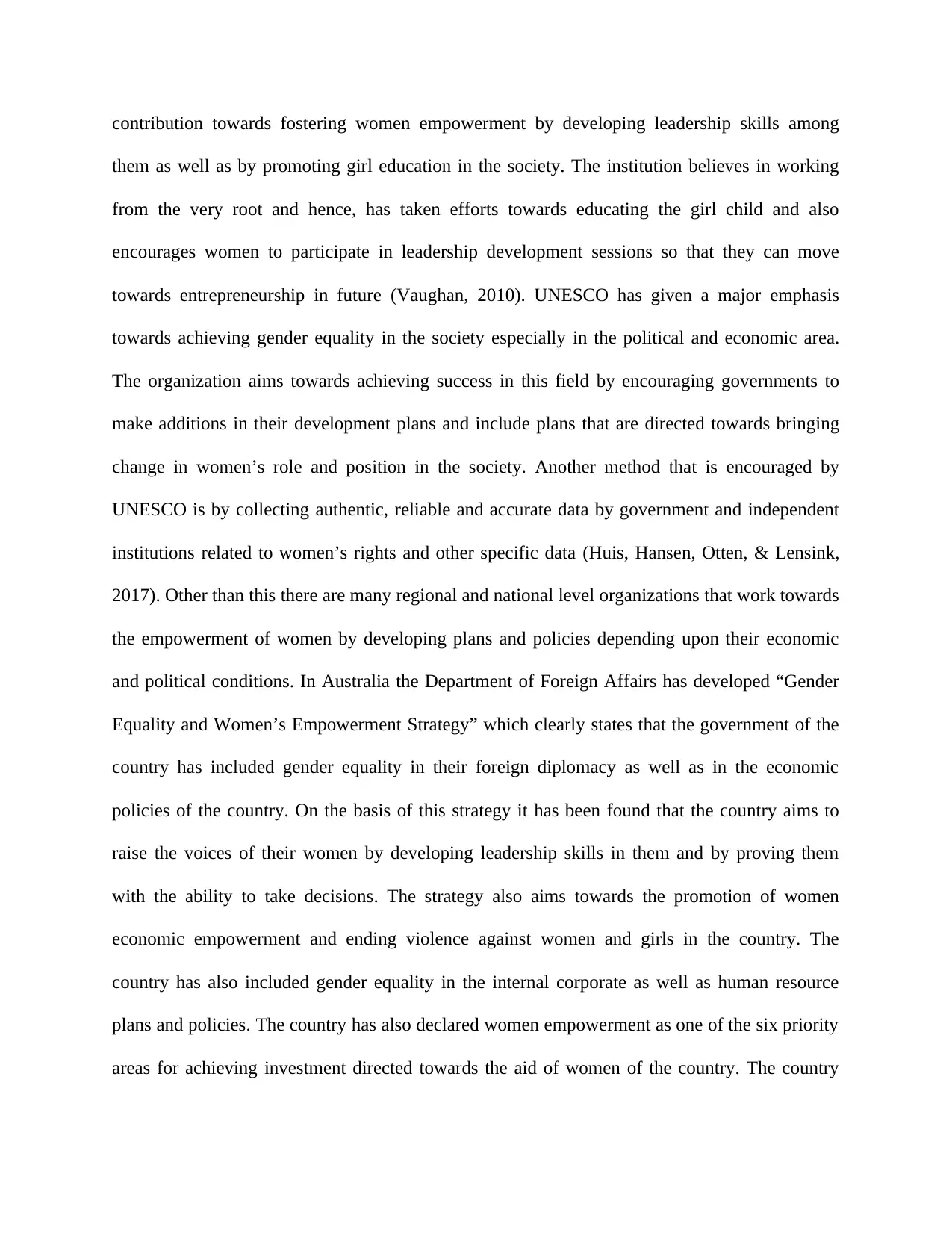
contribution towards fostering women empowerment by developing leadership skills among
them as well as by promoting girl education in the society. The institution believes in working
from the very root and hence, has taken efforts towards educating the girl child and also
encourages women to participate in leadership development sessions so that they can move
towards entrepreneurship in future (Vaughan, 2010). UNESCO has given a major emphasis
towards achieving gender equality in the society especially in the political and economic area.
The organization aims towards achieving success in this field by encouraging governments to
make additions in their development plans and include plans that are directed towards bringing
change in women’s role and position in the society. Another method that is encouraged by
UNESCO is by collecting authentic, reliable and accurate data by government and independent
institutions related to women’s rights and other specific data (Huis, Hansen, Otten, & Lensink,
2017). Other than this there are many regional and national level organizations that work towards
the empowerment of women by developing plans and policies depending upon their economic
and political conditions. In Australia the Department of Foreign Affairs has developed “Gender
Equality and Women’s Empowerment Strategy” which clearly states that the government of the
country has included gender equality in their foreign diplomacy as well as in the economic
policies of the country. On the basis of this strategy it has been found that the country aims to
raise the voices of their women by developing leadership skills in them and by proving them
with the ability to take decisions. The strategy also aims towards the promotion of women
economic empowerment and ending violence against women and girls in the country. The
country has also included gender equality in the internal corporate as well as human resource
plans and policies. The country has also declared women empowerment as one of the six priority
areas for achieving investment directed towards the aid of women of the country. The country
them as well as by promoting girl education in the society. The institution believes in working
from the very root and hence, has taken efforts towards educating the girl child and also
encourages women to participate in leadership development sessions so that they can move
towards entrepreneurship in future (Vaughan, 2010). UNESCO has given a major emphasis
towards achieving gender equality in the society especially in the political and economic area.
The organization aims towards achieving success in this field by encouraging governments to
make additions in their development plans and include plans that are directed towards bringing
change in women’s role and position in the society. Another method that is encouraged by
UNESCO is by collecting authentic, reliable and accurate data by government and independent
institutions related to women’s rights and other specific data (Huis, Hansen, Otten, & Lensink,
2017). Other than this there are many regional and national level organizations that work towards
the empowerment of women by developing plans and policies depending upon their economic
and political conditions. In Australia the Department of Foreign Affairs has developed “Gender
Equality and Women’s Empowerment Strategy” which clearly states that the government of the
country has included gender equality in their foreign diplomacy as well as in the economic
policies of the country. On the basis of this strategy it has been found that the country aims to
raise the voices of their women by developing leadership skills in them and by proving them
with the ability to take decisions. The strategy also aims towards the promotion of women
economic empowerment and ending violence against women and girls in the country. The
country has also included gender equality in the internal corporate as well as human resource
plans and policies. The country has also declared women empowerment as one of the six priority
areas for achieving investment directed towards the aid of women of the country. The country
⊘ This is a preview!⊘
Do you want full access?
Subscribe today to unlock all pages.

Trusted by 1+ million students worldwide

has adopted a two track approach dedicated towards women empowerment. The first track is
related to the funds collected towards undertaking specific gender equality and women
empowerment activities. This is the area where gender equality in the country is slow and needs
immediate attention and action. The second track is related to the government’s target that is at
least 80 per cent of the investments must address the issues related to gender inequality (Rimmer
& Sawer, 2016). Australian government has taken efforts towards many different areas that are
directly or indirectly related to women and their poor conditions. These areas include poverty,
health, education, economy, violence, institutional mechanisms, media, environment, human
rights, etc. Government is taking all the possible efforts to improve the decision making power of
women, making attempts towards increasing girl child admission in schools, providing necessary
training and education that is required for their professional development that will help them to
grow and prosper at their workplace as well as in the economy, etc. (Crawford & Pini, 2010).
Because of these efforts by different governmental and international organization it has been
seen that a remarkable change has been seen in the position of women in the society and a
measurable improvement has been seen in the women economic empowerment
Different stakeholders involved in women empowerment
Endalcachew (2016) has argued that there are many different stakeholders that work towards the
improvement of women in the society. One of the major stakeholders of this is the political party
of a country. The government of a country has the ability to frame plans and policies that can
help achieve the goals of women empowerment. A combined effort of the government and
different institutions towards eradicating the issues that act as a hindrance towards the ultimate
goal of women empowerment can work wonders in this field (Bayeh, 2016). Civil society is an
important stakeholder in achieving gender equality and empowering women in the society. Civil
related to the funds collected towards undertaking specific gender equality and women
empowerment activities. This is the area where gender equality in the country is slow and needs
immediate attention and action. The second track is related to the government’s target that is at
least 80 per cent of the investments must address the issues related to gender inequality (Rimmer
& Sawer, 2016). Australian government has taken efforts towards many different areas that are
directly or indirectly related to women and their poor conditions. These areas include poverty,
health, education, economy, violence, institutional mechanisms, media, environment, human
rights, etc. Government is taking all the possible efforts to improve the decision making power of
women, making attempts towards increasing girl child admission in schools, providing necessary
training and education that is required for their professional development that will help them to
grow and prosper at their workplace as well as in the economy, etc. (Crawford & Pini, 2010).
Because of these efforts by different governmental and international organization it has been
seen that a remarkable change has been seen in the position of women in the society and a
measurable improvement has been seen in the women economic empowerment
Different stakeholders involved in women empowerment
Endalcachew (2016) has argued that there are many different stakeholders that work towards the
improvement of women in the society. One of the major stakeholders of this is the political party
of a country. The government of a country has the ability to frame plans and policies that can
help achieve the goals of women empowerment. A combined effort of the government and
different institutions towards eradicating the issues that act as a hindrance towards the ultimate
goal of women empowerment can work wonders in this field (Bayeh, 2016). Civil society is an
important stakeholder in achieving gender equality and empowering women in the society. Civil
Paraphrase This Document
Need a fresh take? Get an instant paraphrase of this document with our AI Paraphraser
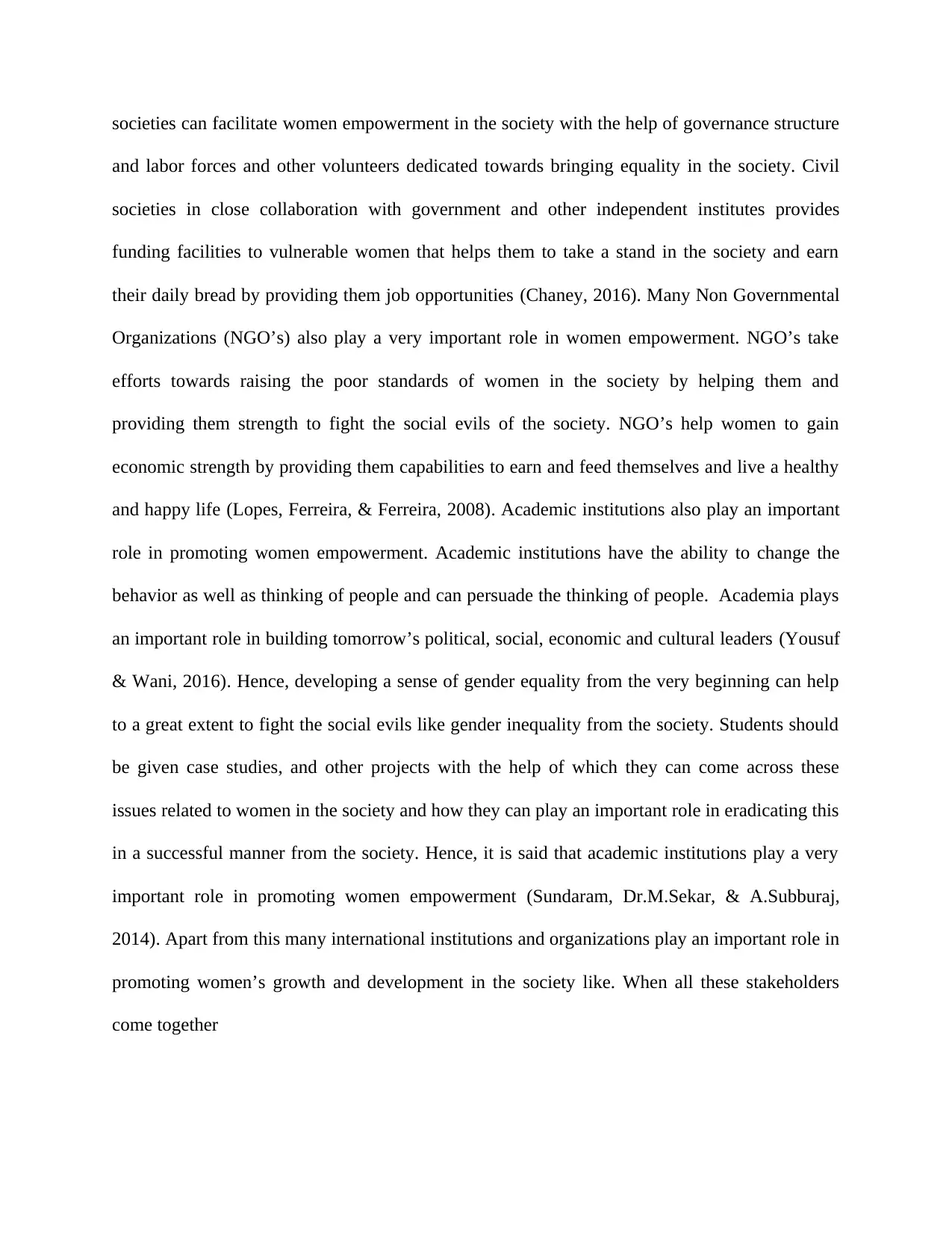
societies can facilitate women empowerment in the society with the help of governance structure
and labor forces and other volunteers dedicated towards bringing equality in the society. Civil
societies in close collaboration with government and other independent institutes provides
funding facilities to vulnerable women that helps them to take a stand in the society and earn
their daily bread by providing them job opportunities (Chaney, 2016). Many Non Governmental
Organizations (NGO’s) also play a very important role in women empowerment. NGO’s take
efforts towards raising the poor standards of women in the society by helping them and
providing them strength to fight the social evils of the society. NGO’s help women to gain
economic strength by providing them capabilities to earn and feed themselves and live a healthy
and happy life (Lopes, Ferreira, & Ferreira, 2008). Academic institutions also play an important
role in promoting women empowerment. Academic institutions have the ability to change the
behavior as well as thinking of people and can persuade the thinking of people. Academia plays
an important role in building tomorrow’s political, social, economic and cultural leaders (Yousuf
& Wani, 2016). Hence, developing a sense of gender equality from the very beginning can help
to a great extent to fight the social evils like gender inequality from the society. Students should
be given case studies, and other projects with the help of which they can come across these
issues related to women in the society and how they can play an important role in eradicating this
in a successful manner from the society. Hence, it is said that academic institutions play a very
important role in promoting women empowerment (Sundaram, Dr.M.Sekar, & A.Subburaj,
2014). Apart from this many international institutions and organizations play an important role in
promoting women’s growth and development in the society like. When all these stakeholders
come together
and labor forces and other volunteers dedicated towards bringing equality in the society. Civil
societies in close collaboration with government and other independent institutes provides
funding facilities to vulnerable women that helps them to take a stand in the society and earn
their daily bread by providing them job opportunities (Chaney, 2016). Many Non Governmental
Organizations (NGO’s) also play a very important role in women empowerment. NGO’s take
efforts towards raising the poor standards of women in the society by helping them and
providing them strength to fight the social evils of the society. NGO’s help women to gain
economic strength by providing them capabilities to earn and feed themselves and live a healthy
and happy life (Lopes, Ferreira, & Ferreira, 2008). Academic institutions also play an important
role in promoting women empowerment. Academic institutions have the ability to change the
behavior as well as thinking of people and can persuade the thinking of people. Academia plays
an important role in building tomorrow’s political, social, economic and cultural leaders (Yousuf
& Wani, 2016). Hence, developing a sense of gender equality from the very beginning can help
to a great extent to fight the social evils like gender inequality from the society. Students should
be given case studies, and other projects with the help of which they can come across these
issues related to women in the society and how they can play an important role in eradicating this
in a successful manner from the society. Hence, it is said that academic institutions play a very
important role in promoting women empowerment (Sundaram, Dr.M.Sekar, & A.Subburaj,
2014). Apart from this many international institutions and organizations play an important role in
promoting women’s growth and development in the society like. When all these stakeholders
come together
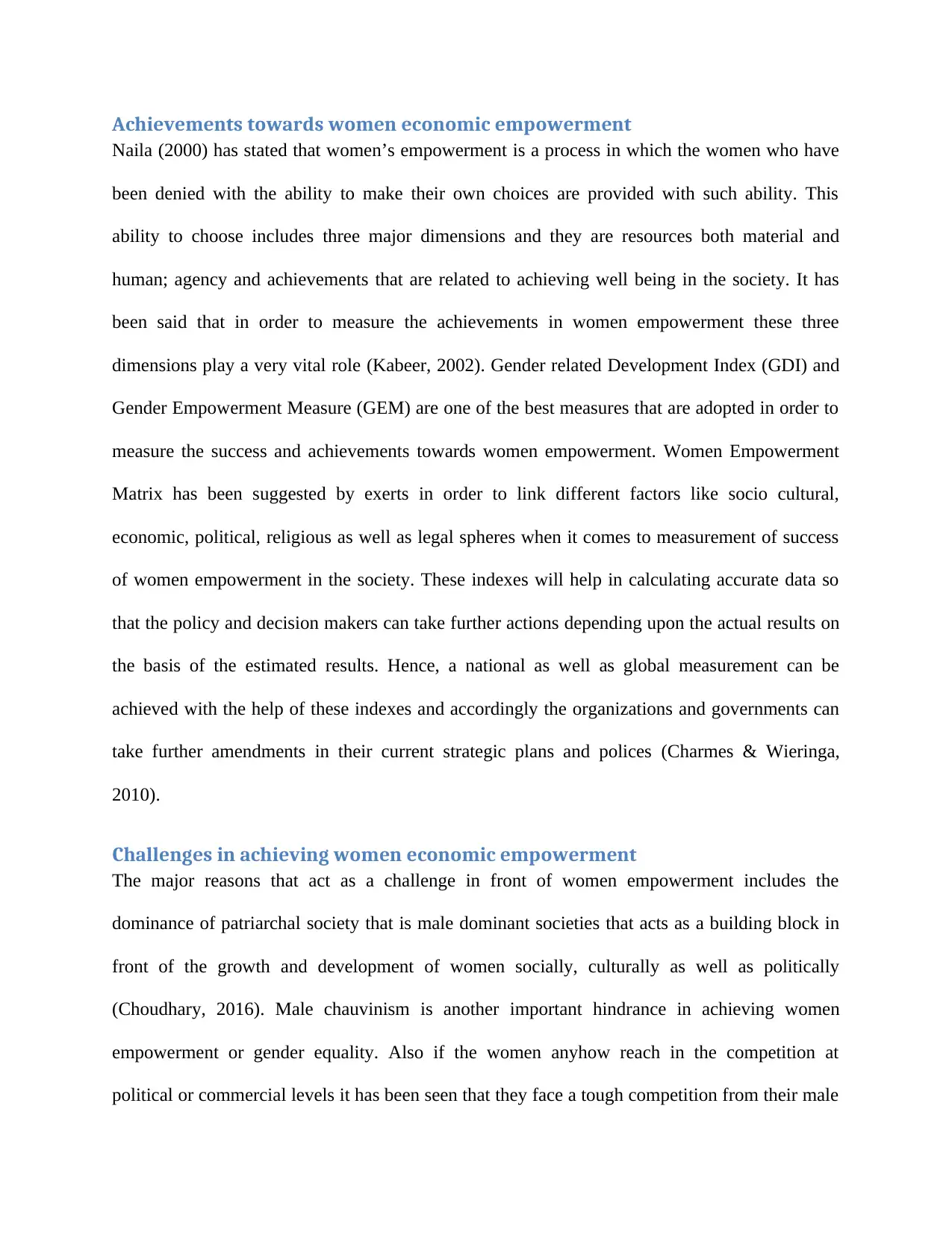
Achievements towards women economic empowerment
Naila (2000) has stated that women’s empowerment is a process in which the women who have
been denied with the ability to make their own choices are provided with such ability. This
ability to choose includes three major dimensions and they are resources both material and
human; agency and achievements that are related to achieving well being in the society. It has
been said that in order to measure the achievements in women empowerment these three
dimensions play a very vital role (Kabeer, 2002). Gender related Development Index (GDI) and
Gender Empowerment Measure (GEM) are one of the best measures that are adopted in order to
measure the success and achievements towards women empowerment. Women Empowerment
Matrix has been suggested by exerts in order to link different factors like socio cultural,
economic, political, religious as well as legal spheres when it comes to measurement of success
of women empowerment in the society. These indexes will help in calculating accurate data so
that the policy and decision makers can take further actions depending upon the actual results on
the basis of the estimated results. Hence, a national as well as global measurement can be
achieved with the help of these indexes and accordingly the organizations and governments can
take further amendments in their current strategic plans and polices (Charmes & Wieringa,
2010).
Challenges in achieving women economic empowerment
The major reasons that act as a challenge in front of women empowerment includes the
dominance of patriarchal society that is male dominant societies that acts as a building block in
front of the growth and development of women socially, culturally as well as politically
(Choudhary, 2016). Male chauvinism is another important hindrance in achieving women
empowerment or gender equality. Also if the women anyhow reach in the competition at
political or commercial levels it has been seen that they face a tough competition from their male
Naila (2000) has stated that women’s empowerment is a process in which the women who have
been denied with the ability to make their own choices are provided with such ability. This
ability to choose includes three major dimensions and they are resources both material and
human; agency and achievements that are related to achieving well being in the society. It has
been said that in order to measure the achievements in women empowerment these three
dimensions play a very vital role (Kabeer, 2002). Gender related Development Index (GDI) and
Gender Empowerment Measure (GEM) are one of the best measures that are adopted in order to
measure the success and achievements towards women empowerment. Women Empowerment
Matrix has been suggested by exerts in order to link different factors like socio cultural,
economic, political, religious as well as legal spheres when it comes to measurement of success
of women empowerment in the society. These indexes will help in calculating accurate data so
that the policy and decision makers can take further actions depending upon the actual results on
the basis of the estimated results. Hence, a national as well as global measurement can be
achieved with the help of these indexes and accordingly the organizations and governments can
take further amendments in their current strategic plans and polices (Charmes & Wieringa,
2010).
Challenges in achieving women economic empowerment
The major reasons that act as a challenge in front of women empowerment includes the
dominance of patriarchal society that is male dominant societies that acts as a building block in
front of the growth and development of women socially, culturally as well as politically
(Choudhary, 2016). Male chauvinism is another important hindrance in achieving women
empowerment or gender equality. Also if the women anyhow reach in the competition at
political or commercial levels it has been seen that they face a tough competition from their male
⊘ This is a preview!⊘
Do you want full access?
Subscribe today to unlock all pages.

Trusted by 1+ million students worldwide
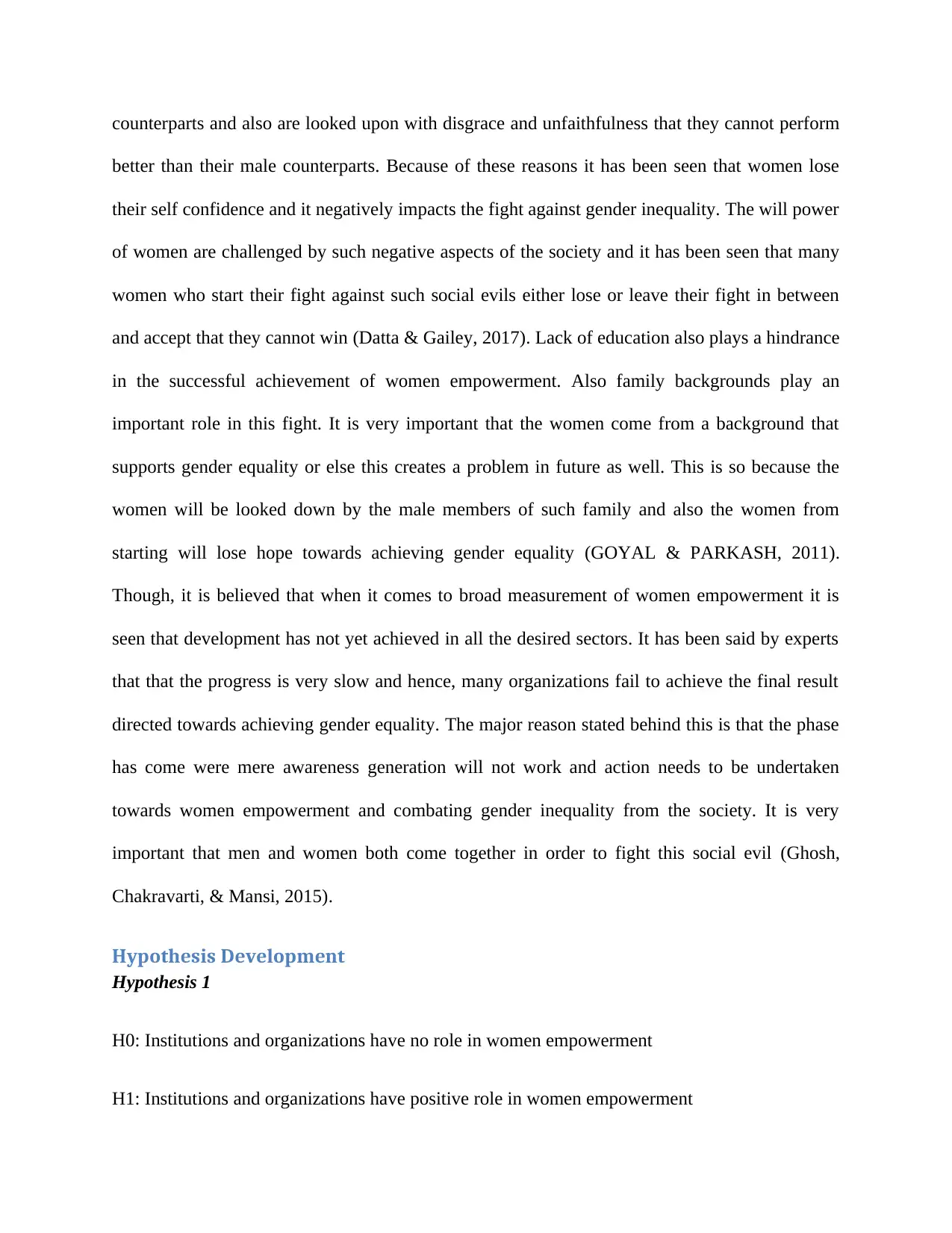
counterparts and also are looked upon with disgrace and unfaithfulness that they cannot perform
better than their male counterparts. Because of these reasons it has been seen that women lose
their self confidence and it negatively impacts the fight against gender inequality. The will power
of women are challenged by such negative aspects of the society and it has been seen that many
women who start their fight against such social evils either lose or leave their fight in between
and accept that they cannot win (Datta & Gailey, 2017). Lack of education also plays a hindrance
in the successful achievement of women empowerment. Also family backgrounds play an
important role in this fight. It is very important that the women come from a background that
supports gender equality or else this creates a problem in future as well. This is so because the
women will be looked down by the male members of such family and also the women from
starting will lose hope towards achieving gender equality (GOYAL & PARKASH, 2011).
Though, it is believed that when it comes to broad measurement of women empowerment it is
seen that development has not yet achieved in all the desired sectors. It has been said by experts
that that the progress is very slow and hence, many organizations fail to achieve the final result
directed towards achieving gender equality. The major reason stated behind this is that the phase
has come were mere awareness generation will not work and action needs to be undertaken
towards women empowerment and combating gender inequality from the society. It is very
important that men and women both come together in order to fight this social evil (Ghosh,
Chakravarti, & Mansi, 2015).
Hypothesis Development
Hypothesis 1
H0: Institutions and organizations have no role in women empowerment
H1: Institutions and organizations have positive role in women empowerment
better than their male counterparts. Because of these reasons it has been seen that women lose
their self confidence and it negatively impacts the fight against gender inequality. The will power
of women are challenged by such negative aspects of the society and it has been seen that many
women who start their fight against such social evils either lose or leave their fight in between
and accept that they cannot win (Datta & Gailey, 2017). Lack of education also plays a hindrance
in the successful achievement of women empowerment. Also family backgrounds play an
important role in this fight. It is very important that the women come from a background that
supports gender equality or else this creates a problem in future as well. This is so because the
women will be looked down by the male members of such family and also the women from
starting will lose hope towards achieving gender equality (GOYAL & PARKASH, 2011).
Though, it is believed that when it comes to broad measurement of women empowerment it is
seen that development has not yet achieved in all the desired sectors. It has been said by experts
that that the progress is very slow and hence, many organizations fail to achieve the final result
directed towards achieving gender equality. The major reason stated behind this is that the phase
has come were mere awareness generation will not work and action needs to be undertaken
towards women empowerment and combating gender inequality from the society. It is very
important that men and women both come together in order to fight this social evil (Ghosh,
Chakravarti, & Mansi, 2015).
Hypothesis Development
Hypothesis 1
H0: Institutions and organizations have no role in women empowerment
H1: Institutions and organizations have positive role in women empowerment
Paraphrase This Document
Need a fresh take? Get an instant paraphrase of this document with our AI Paraphraser
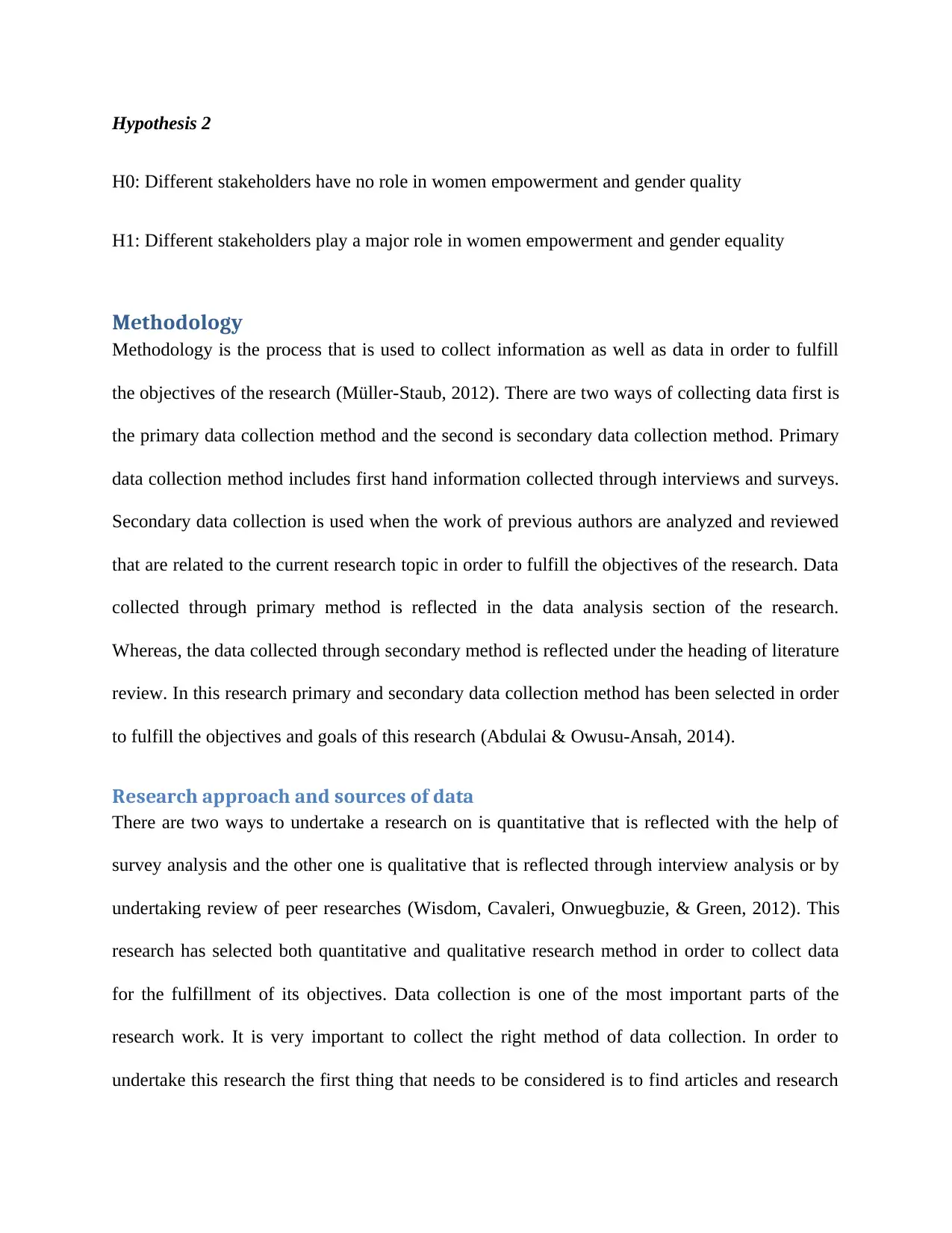
Hypothesis 2
H0: Different stakeholders have no role in women empowerment and gender quality
H1: Different stakeholders play a major role in women empowerment and gender equality
Methodology
Methodology is the process that is used to collect information as well as data in order to fulfill
the objectives of the research (Müller-Staub, 2012). There are two ways of collecting data first is
the primary data collection method and the second is secondary data collection method. Primary
data collection method includes first hand information collected through interviews and surveys.
Secondary data collection is used when the work of previous authors are analyzed and reviewed
that are related to the current research topic in order to fulfill the objectives of the research. Data
collected through primary method is reflected in the data analysis section of the research.
Whereas, the data collected through secondary method is reflected under the heading of literature
review. In this research primary and secondary data collection method has been selected in order
to fulfill the objectives and goals of this research (Abdulai & Owusu-Ansah, 2014).
Research approach and sources of data
There are two ways to undertake a research on is quantitative that is reflected with the help of
survey analysis and the other one is qualitative that is reflected through interview analysis or by
undertaking review of peer researches (Wisdom, Cavaleri, Onwuegbuzie, & Green, 2012). This
research has selected both quantitative and qualitative research method in order to collect data
for the fulfillment of its objectives. Data collection is one of the most important parts of the
research work. It is very important to collect the right method of data collection. In order to
undertake this research the first thing that needs to be considered is to find articles and research
H0: Different stakeholders have no role in women empowerment and gender quality
H1: Different stakeholders play a major role in women empowerment and gender equality
Methodology
Methodology is the process that is used to collect information as well as data in order to fulfill
the objectives of the research (Müller-Staub, 2012). There are two ways of collecting data first is
the primary data collection method and the second is secondary data collection method. Primary
data collection method includes first hand information collected through interviews and surveys.
Secondary data collection is used when the work of previous authors are analyzed and reviewed
that are related to the current research topic in order to fulfill the objectives of the research. Data
collected through primary method is reflected in the data analysis section of the research.
Whereas, the data collected through secondary method is reflected under the heading of literature
review. In this research primary and secondary data collection method has been selected in order
to fulfill the objectives and goals of this research (Abdulai & Owusu-Ansah, 2014).
Research approach and sources of data
There are two ways to undertake a research on is quantitative that is reflected with the help of
survey analysis and the other one is qualitative that is reflected through interview analysis or by
undertaking review of peer researches (Wisdom, Cavaleri, Onwuegbuzie, & Green, 2012). This
research has selected both quantitative and qualitative research method in order to collect data
for the fulfillment of its objectives. Data collection is one of the most important parts of the
research work. It is very important to collect the right method of data collection. In order to
undertake this research the first thing that needs to be considered is to find articles and research
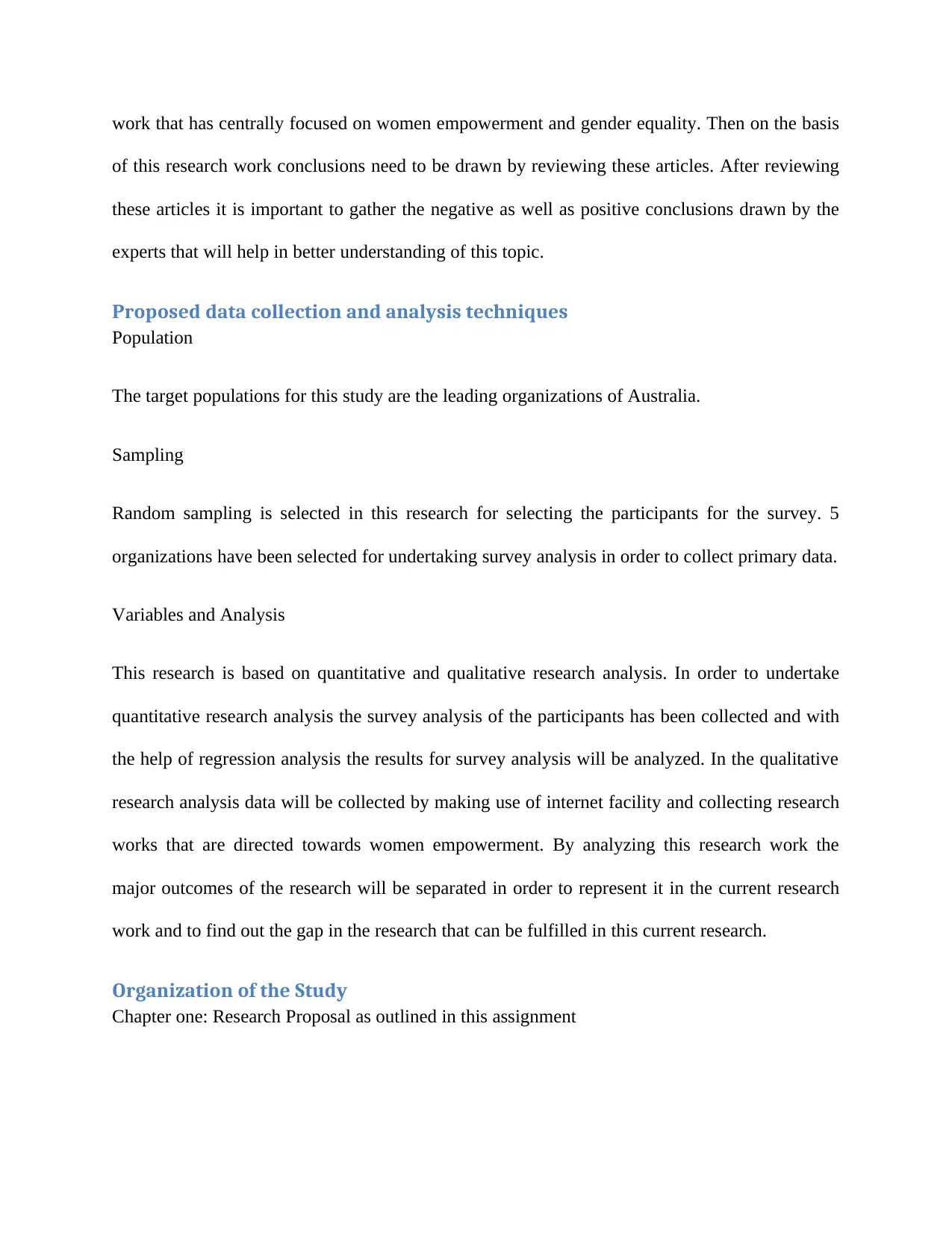
work that has centrally focused on women empowerment and gender equality. Then on the basis
of this research work conclusions need to be drawn by reviewing these articles. After reviewing
these articles it is important to gather the negative as well as positive conclusions drawn by the
experts that will help in better understanding of this topic.
Proposed data collection and analysis techniques
Population
The target populations for this study are the leading organizations of Australia.
Sampling
Random sampling is selected in this research for selecting the participants for the survey. 5
organizations have been selected for undertaking survey analysis in order to collect primary data.
Variables and Analysis
This research is based on quantitative and qualitative research analysis. In order to undertake
quantitative research analysis the survey analysis of the participants has been collected and with
the help of regression analysis the results for survey analysis will be analyzed. In the qualitative
research analysis data will be collected by making use of internet facility and collecting research
works that are directed towards women empowerment. By analyzing this research work the
major outcomes of the research will be separated in order to represent it in the current research
work and to find out the gap in the research that can be fulfilled in this current research.
Organization of the Study
Chapter one: Research Proposal as outlined in this assignment
of this research work conclusions need to be drawn by reviewing these articles. After reviewing
these articles it is important to gather the negative as well as positive conclusions drawn by the
experts that will help in better understanding of this topic.
Proposed data collection and analysis techniques
Population
The target populations for this study are the leading organizations of Australia.
Sampling
Random sampling is selected in this research for selecting the participants for the survey. 5
organizations have been selected for undertaking survey analysis in order to collect primary data.
Variables and Analysis
This research is based on quantitative and qualitative research analysis. In order to undertake
quantitative research analysis the survey analysis of the participants has been collected and with
the help of regression analysis the results for survey analysis will be analyzed. In the qualitative
research analysis data will be collected by making use of internet facility and collecting research
works that are directed towards women empowerment. By analyzing this research work the
major outcomes of the research will be separated in order to represent it in the current research
work and to find out the gap in the research that can be fulfilled in this current research.
Organization of the Study
Chapter one: Research Proposal as outlined in this assignment
⊘ This is a preview!⊘
Do you want full access?
Subscribe today to unlock all pages.

Trusted by 1+ million students worldwide
1 out of 15
Related Documents
Your All-in-One AI-Powered Toolkit for Academic Success.
+13062052269
info@desklib.com
Available 24*7 on WhatsApp / Email
![[object Object]](/_next/static/media/star-bottom.7253800d.svg)
Unlock your academic potential
Copyright © 2020–2025 A2Z Services. All Rights Reserved. Developed and managed by ZUCOL.



